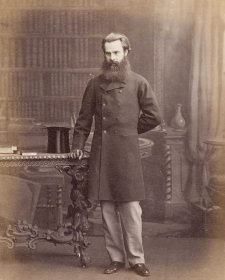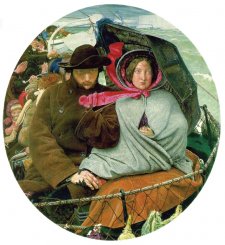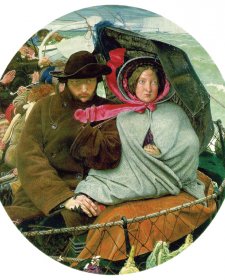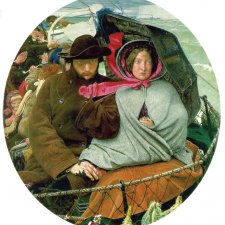Thomas Woolner, sculptor, studied first with the brothers Henry and William Behnes, painter and sculptor respectively, and later at the Royal Academy, at which he was to become professor of sculpture in his fifties. As a young man he was a founding member of the Pre-Raphaelite Brotherhood and contributed poems to its journal, The Germ, including ‘My Beautiful Lady’, expanding at some length on the themes ‘I love my lady, she is very fair/ Her brow is wan, and bound by simple hair’. His small sculpture Eleanor sucking the Poison from Prince Edward’s Wound (1843), exhibited at the Royal Academy, attracted much attention, but by 1850 he was engaged mostly on medallion portraits.
Woolner came to Australia in1852 to try his luck on the Victorian goldfields, but was appalled by the conditions and soon resumed his sculptural work, making a number of plaster medallions of prominent Melbourne citizens including La Trobe. In 1854, Woolner spent a happy six months in Sydney, where various families and individuals commissioned portrait medallions. In all, during his stay in Australia, Woolner produced 24 portrait medallions. Some portraits, including those of LaTrobe and Wentworth, were copied more often than others. There were 25 subscribers listed for the LaTrobe medallion in the Melbourne Banner of 28 February 1854. Over a few months in 1854, print-sellers Woolcott and Clark at 555 George Street Sydney advertised that those interested in subscribing to a specimen of the Wentworth medallion could inspect the plaster version at their premises in Sydney. Woolner was heading for England on the Queen of the South; there, he would have his plaster impressions cast by the finest artisans in bronze, for shipment back to the colony. The price was five guineas per medallion and Woolcott and Clark promised that subscribers would receive their portraits within twelve months. Although he was commended for the likeness of Wentworth in the portrait medallion, he failed to obtain the hoped-for commission for the full-length statue of Wentworth that now stands in the Great Hall of the University of Sydney.
Having returned to England with his case of colonial medallions, Woolner continued his portrait sculpture practice. He made medallions of Tennyson, Browning, Carlyle, Palgrave and Hooker, amongst others; Gladstone, Darwin, Dickens, Huxley, Charles Kingsley, and Lord Cavendish were amongst his subjects. He made the statue of Lord Lawrence, Viceroy of India for Government House, Calcutta; that of Sir Stamford Raffles currently in Empress Place, Singapore; the statue of John Stuart Mill that stands on the Thames Embankment; and a bust of Alfred, Lord Tennyson for Westminster Abbey. He made the life-sized statue of Francis Bacon, Lord Verulam, for the New Museum at Oxford and in 1879 he was commissioned to make the statue of Captain Cook that stands near the Australian Museum in Sydney. Woolner died the day after Tennyson, in October 1892. The National Portrait Gallery, London, has eight of his medallions and eleven of his busts, as well as a plethora of photographs of him.










